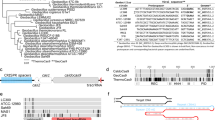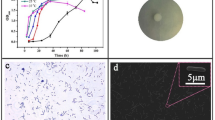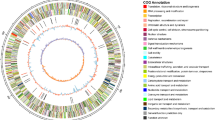Abstract
Thermus thermophilus HB27 is an extremely thermophilic, halotolerant bacterium, which was originally isolated from a natural thermal environment in Japan. This organism has considerable biotechnological potential; many thermostable proteins isolated from members of the genus Thermus are indispensable in research and in industrial applications. We present here the complete genome sequence of T. thermophilus HB27, the first for the genus Thermus. The genome consists of a 1,894,877 base pair chromosome and a 232,605 base pair megaplasmid, designated pTT27. The 2,218 identified putative genes were compared to those of the closest relative sequenced so far, the mesophilic bacterium Deinococcus radiodurans. Both organisms share a similar set of proteins, although their genomes lack extensive synteny. Many new genes of potential interest for biotechnological applications were found in T. thermophilus HB27. Candidates include various proteases and key enzymes of other fundamental biological processes such as DNA replication, DNA repair and RNA maturation.
This is a preview of subscription content, access via your institution
Access options
Subscribe to this journal
Receive 12 print issues and online access
$209.00 per year
only $17.42 per issue
Buy this article
- Purchase on Springer Link
- Instant access to full article PDF
Prices may be subject to local taxes which are calculated during checkout



Similar content being viewed by others
References
Brock, T.D. & Freeze, H. Thermus aquaticus gen. n. and sp. n., a nonsporulating extreme thermophile. J. Bacteriol. 98, 289–297 (1969).
Oshima, T. & Imahori, K. Description of Thermus thermophilus (Yoshida and Oshima) comb. nov., a nonsporulating thermophilic bacterium from a Japanese thermal spa. Int. J. Syst. Bacteriol. 24, 102–112 (1974).
Williams, R.A., Smith, K.E., Welch, S.G., Micallef, J. & Sharp, R.J. DNA relatedness of Thermus strains, description of Thermus brockianus sp. nov., and proposal to reestablish Thermus thermophilus (Oshima and Imahori). Int. J. Syst. Bacteriol. 45, 495–499 (1995).
Koyama, Y., Hoshino, T., Tomizuka, N. & Furukawa, K. Genetic transformation of the extreme thermophile Thermus thermophilus and of other Thermus spp. J. Bacteriol. 166, 338–340 (1986).
Friedrich, A., Prust, C., Hartsch, T., Henne, A. & Averhoff, B. Molecular analyses of the natural transformation machinery and identification of pilus structures in the extremely thermophilic bacterium Thermus thermophilus strain HB27. Appl. Environ. Microbiol. 68, 745–755 (2002).
Wimberly, B.T. et al. Structure of the 30S ribosomal subunit. Nature 407, 327–339 (2000).
Vieille, C. & Zeikus, G.J. Hyperthermophilic enzymes: sources, uses, and molecular mechanisms for thermostability. Microbiol. Mol. Biol. Rev. 65, 1–43 (2001).
Sterner, R. & Liebl, W. Thermophilic adaptation of proteins. Crit. Rev. Biochem. Mol. Biol. 36, 39–106 (2001).
Pantazaki, A.A., Pritsa, A.A. & Kyriakidis, D.A. Biotechnologically relevant enzymes from Thermus thermophilus. Appl. Microbiol. Biotechnol. 58, 1–12 (2002).
Niehaus, F., Bertoldo, C., Kahler, M. & Antranikian, G. Extremophiles as a source of novel enzymes for industrial application. Appl. Microbiol. Biotechnol. 51, 711–729 (1999).
Weisburg, W.G., Giovannoni, S.J. & Woese, C.R. The Deinococcus-Thermus phylum and the effect of rRNA composition on phylogenetic tree construction. Syst. Appl. Microbiol. 11, 128–134 (1989).
Hensel, R., Demharter, W., Kandler, O., Kroppenstedt, R.M. & Stackebrandt, E. Chemotaxonomic and molecular-genetic studies of the genus Thermus: evidence for a phylogenetic relationship of Thermus aquaticus and Thermus ruber to the genus Deinococcus. Int. J. Syst. Bacteriol. 36, 444–453 (1986).
White, O. et al. Genome sequence of the radioresistant bacterium Deinococcus radiodurans R1. Science 286, 1571–1577 (1999).
Makarova, K.S. et al. Genome of the extremely radiation-resistant bacterium Deinococcus radiodurans viewed from the perspective of comparative genomics. Microbiol. Mol. Biol. Rev. 65, 44–79 (2001).
Fryxell, K.J. & Zuckerkandl, E. Cytosine deamination plays a primary role in the evolution of mammalian isochores. Mol. Biol. Evol. 17, 1371–1383 (2000).
Starkuviene, V. & Fritz, H.J. A novel type of uracil-DNA glycosylase mediating repair of hydrolytic DNA damage in the extremely thermophilic eubacterium Thermus thermophilus. Nucleic Acids Res. 30, 2097–2102 (2002).
Friedrich, A., Rumszauer, J., Henne, A. & Averhoff, B. Pilin-like proteins in the extremely thermophilic bacterium Thermus thermophilus HB27: implication in competence for natural transformation and links to type IV pilus biogenesis. Appl. Environ. Microbiol. 69, 3695–3700 (2003).
Slesarev, A.I., et al. The complete genome of hyperthermophile Methanopyrus kandleri AV19 and monophyly of archaeal methanogens. Proc. Natl. Acad. Sci. USA 99, 4644–4649 (2002).
Mather, M.W., Springer, P., Hensel, S., Buse, G. & Fee, J.A. Cytochrome oxidase genes from Thermus thermophilus. Nucleotide sequence of the fused gene and analysis of the deduced primary structures for subunits I and III of cytochrome caa3. J. Biol. Chem. 268, 5395–5408 (1993).
Soulimane, T. et al. Structure and mechanism of the aberrant ba(3)-cytochrome c oxidase from Thermus thermophilus. EMBO J. 19, 1766–1776 (2000).
Yamaguchi, M., Stout, C.D. & Hatefi, Y. The proton channel of the energy-transducing nicotinamide nucleotide transhydrogenase of Escherichia coli. J. Biol. Chem. 277, 33670–33675 (2002).
Yokoyama, K. et al. V-type H+-ATPase/synthase from a thermophilic eubacterium, Thermus thermophilus. Subunit structure and operon. J. Biol. Chem. 275, 13955–13961 (2000).
Ramirez-Arcos, S., Fernandez-Herrero, L.A. & Berenguer, J.A. Thermophilic nitrate reductase is responsible for the strain specific anaerobic growth of Thermus thermophilus HB8. Biochim. Biophys. Acta. 1396, 215–227 (1998).
Krafft, T., Gross, R. & Kroger, A. The function of Wolinella succinogenes psr genes in electron transport with polysulphide as the terminal electron acceptor. Eur. J. Biochem. 230, 601–606 (1995).
Larimer, F.W. et al. Complete genome sequence of the metabolically versatile photosynthetic bacterium Rhodopseudomonas palustris. Nat. Biotechnol. 22, 55–61 (2004).
Martens, J.H., Barg, H., Warren, M.J. & Jahn, D. Microbial production of vitamin B12. Appl. Microbiol. Biotechnol. 58, 275–285 (2002).
Debussche, L., Thibaut, D., Cameron, B., Crouzet, J. & Blanche, F. Biosynthesis of the corrin macrocycle of coenzyme B12 in Pseudomonas denitrificans. J. Bacteriol. 175, 7430–7440 (1993).
Roessner, C.A., Huang, K.X., Warren, M.J., Raux, E. & Scott, A.I. Isolation and characterization of 14 additional genes specifying the anaerobic biosynthesis of cobalamin (vitamin B12) in Propionibacterium freudenreichii (P. shermanii). Microbiology 148, 1845–1853 (2002).
Sandmann, G. Carotenoid biosynthesis and biotechnological application. Arch. Biochem. Biophys. 385, 4–12 (2001).
Nishino, H. et al. Carotenoids in cancer chemoprevention. Cancer Metastasis Rev. 21, 257–264 (2002).
Yokoyama, A., Shizuri, Y., Hoshino, T. & Sandmann, G. Thermocryptoxanthins: novel intermediates in the carotenoid biosynthetic pathway of Thermus thermophilus. Arch. Microbiol. 165, 342–345 (1996).
Tabata, K., Ishida, S., Nakahara, T. & Hoshino, T. A carotenogenic gene cluster exists on a large plasmid in Thermus thermophilus. FEBS Lett. 341, 251–255 (1994).
Hoshino, T., Fujii, R. & Nakahara, T. Molecular cloning and sequence analysis of the crtB gene of Thermus thermophilus HB27, an extreme thermophile producing carotenoid pigments. Appl. Environ. Microbiol. 59, 3150–3153 (1993).
Daniel, R.M., Toogood, H.S. & Bergquist, P.L. Thermostable proteases. Biotechnol. Genet. Eng. Rev. 13, 51–100 (1996).
Rowsell, S. et al. Crystal structure of carboxypeptidase G2, a bacterial enzyme with applications in cancer therapy. Structure 5, 337–347 (1997).
Suzuki, Y., Hatagaki, K. & Oda, H. A hyperthermostable pullulanase produced by an extreme thermophile, Bacillus flavocaldarius KP 1228, and evidence for the proline theory of increasing protein thermostability. Appl. Microbiol. Biotechnol. 34, 707–714 (1991).
Jaeger, K.E., Dijkstra, B.W. & Reetz, M.T. Bacterial biocatalysts: molecular biology, three-dimensional structures, and biotechnological applications of lipases. Annu. Rev. Microbiol. 53, 315–351 (1999).
Ruttimann, C., Cotoras, M., Zaldivar, J. & Vicuna, R. DNA polymerases from the extremely thermophilic bacterium Thermus thermophilus HB-8. Eur. J. Biochem. 149, 41–46 (1985).
Bullard, J.M. et al. DNA polymerase III holoenzyme from Thermus thermophilus: identification, expression, purification of components, and use to reconstitute a processive replicase. J. Biol. Chem. 277, 13401–13408 (2002).
Pantazaki, A.A., Karagiorgas, A.A., Liakopoulou-Kyriakides, M. & Kyriakidis, D.A. Hyperalkaline and thermostable phosphatase in Thermus thermophilus. Appl. Biochem. Biotechnol. 75, 249–259 (1998).
Adachi, O. et al. New developments in oxidative fermentation. Appl. Microbiol. Biotechnol. 60, 643–653 (2003).
Quintela, J.C., Pittenauer, E., Allmaier, G., Aran, V. & de Pedro, M.A. Structure of peptidoglycan from Thermus thermophilus HB8. J. Bacteriol. 177, 4947–4962 (1995).
Chamberlain, N.R. et al. Correlation of carotenoid production, decreased membrane fluidity, and resistance to oleic acid killing in Staphylococcus aureus 18Z. Infect. Immun. 59, 4332–4337 (1991).
Huber, R. et al. Isolation of a hyperthermophilic archaeum predicted by in situ RNA analysis. Nature 376, 57–58 (1995).
Staden, R., Beal, K.F. & Bonfield, J.K. The Staden package, 1998. Methods Mol. Biol. 132, 115–130 (2000).
Tabata, K. & Hoshino, T. Mapping of 61 genes on the refined physical map of the chromosome of Thermus thermophilus HB27 and comparison of genome organization with that of T. thermophilus HB8. Microbiology 142, 401–410 (1996).
Besemer, J., Lomsadze, A. & Borodovsky, M. GeneMarkS: a self-training method for prediction of gene starts in microbial genomes. Implications for finding sequence motifs in regulatory regions. Nucleic Acids Res. 29, 2607–2618 (2001).
Acknowledgements
We are grateful to Reinhard Sterner and Wolfgang Liebl for advice and discussions that helped to shape this project. We thank Takayuki Hoshino for strain confirmation. This work was supported by a grant of the Niedersächisches Ministerium für Wissenschaft und Kultur to the Göttingen Genomics Laboratory and by funds of the Competence Network Göttingen “Genome Research on Bacteria” financed by the German Federal Ministry of Education and Research (BMBF).
Author information
Authors and Affiliations
Corresponding author
Ethics declarations
Competing interests
The authors declare no competing financial interests.
Rights and permissions
About this article
Cite this article
Henne, A., Brüggemann, H., Raasch, C. et al. The genome sequence of the extreme thermophile Thermus thermophilus. Nat Biotechnol 22, 547–553 (2004). https://doi.org/10.1038/nbt956
Received:
Accepted:
Published:
Issue Date:
DOI: https://doi.org/10.1038/nbt956
This article is cited by
-
A functionally uncharacterized type-2 malate/l-lactate dehydrogenase family protein from Thermus thermophilus HB8 catalyzes stereospecific reduction of 2-keto-3-deoxy-d-gluconate
Extremophiles (2022)
-
Efficient genome editing of an extreme thermophile, Thermus thermophilus, using a thermostable Cas9 variant
Scientific Reports (2021)
-
A New Phylogenomic Approach For Quantifying Horizontal Gene Transfer Trends in Prokaryotes
Scientific Reports (2020)
-
Effects of SDS on the activity and conformation of protein tyrosine phosphatase from thermus thermophilus HB27
Scientific Reports (2020)
-
Diverse respiratory capacity among Thermus strains from US Great Basin hot springs
Extremophiles (2020)



